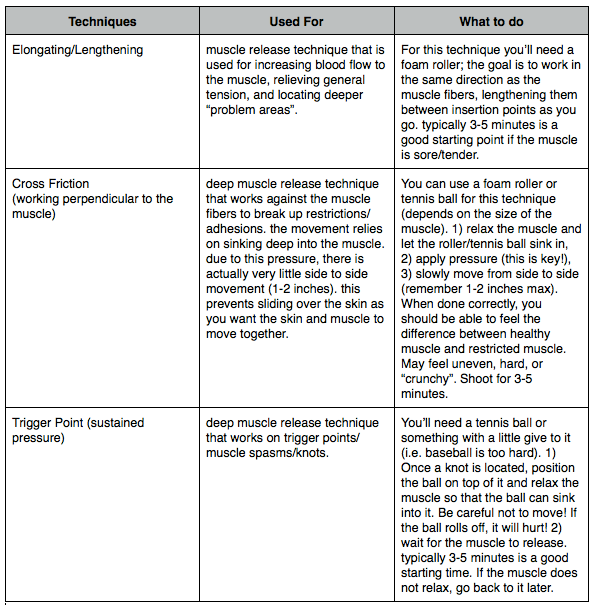Self Muscle Massage- introduction
If you’ve ever watched documentaries following professional athletes or teams, you’ve probably noticed that most of them have regular access to a massage or “bodywork” specialist. This isn’t a coincidence. Research has been studying massage and it’s effects on recovery, lactic acid clearance, muscle soreness and fatigue for the past 20+ years. While the jury may still be out in terms of its’ specific effect on athletic performance and recovery, it has been repeatedly shown to increase soft tissue mobility and blood flow. This is key to maintaining healthy and properly functioning muscles.
But what if you’re not a professional athlete and don’t have a pit crew of specialists at your disposal??? You’re in luck. There are now a variety of tools and resources available to make you into your own private body worker. In fact you’ve probably seen or used some at race expos already in the form of foam rollers, sticks, and other assorted trigger point products. You may even own some. Personally, I’m a big fan not only as a clinician but also as an athlete. They may not save me from every injury, but they certainly help prevent and minimize the frequency of them. The key is learning how to use them so that they can become a regular part of your training routine.
So what do you do with them!?
An easy way to look at self massage is to break it down into three different ways you can loosen up the muscle:
1) You can elongate or stretch out the muscle fibers (in other words, work parallel or in the same direction the muscle runs)
2) You can work perpendicular to the muscle (known as cross friction and used to break up specific adhesions).
3) You can apply sustained pressure to the muscle (known as trigger point and used to relieve muscle spasm).
What you’ll need to get started:
For the first two techniques, you’ll need a foam roller. These days you can find them in some of the larger chain stores in their fitness sections (Target or Walmart for example). If you don’t have any luck there, you will definitely be able to find them in a sporting good or running store. The web is also an excellent source to shop for them as you will be able to see the different shapes and varieties that are available. Expect to spend anywhere from $10-50. My advice when it comes to choosing one: 1) you get what you pay for. over time, foam rollers will break down and loose stiffness, especially with frequent use, and 2) the more condensed versions are easier to travel with to races and training camps.
 Personally, I am a big fan of The Grid (made by trigger point technologies). It’s super stiff and has different pattern types which make it ideal for both elongation and cross friction techniques. It’s also compact and easy to throw in my bag or suitcase (it’s hollow in the middle so I can stuff clothes inside to make up for the lost space).
Personally, I am a big fan of The Grid (made by trigger point technologies). It’s super stiff and has different pattern types which make it ideal for both elongation and cross friction techniques. It’s also compact and easy to throw in my bag or suitcase (it’s hollow in the middle so I can stuff clothes inside to make up for the lost space).
For the third technique (trigger point release), let’s start easy. All you’ll need is a tennis ball. As you get more proficient with the techniques, you may want to upgrade to a more specific “trigger point ball”, but to get the hang of it a tennis ball is all you’ll need.
Over the course of the series, I’m going to take you through the major muscle groups of the body. In each installment there will be an introduction to the muscle groups, directions for how to find them, and a video demonstration of the different muscle release techniques.
In the mean time, here is a video demonstration of the three basic techniques and the key points you’ll need to master them.
Video
Here is a video demonstration of the three basic techniques.













This looks like a great guide.